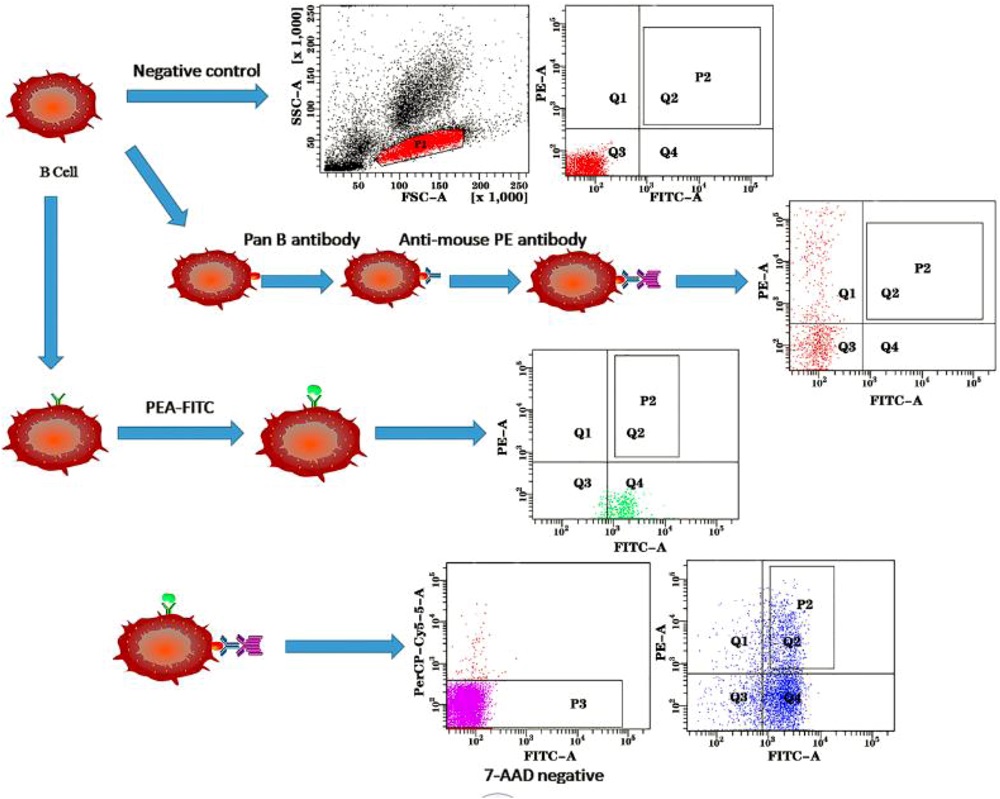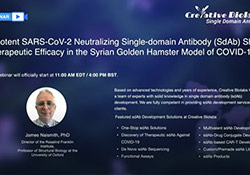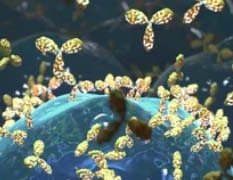Single B-Cell Sorting based Single Domain Antibody (SdAb) Discovery Service
Introduction Highlight Development Process Case Study Published Data FAQ Resources
Creative Biolabs is a leading service provider that specializes in VHH discovery and development. Based on our advanced technology platforms, we have won a good reputation for accomplishing numerous challenging VHH development projects successfully. Now, our scientists with extensive experience in VHH generation will leverage the leading B-cell functional antibody discovery technology to develop specific VHHs.
B-Cell Sorting Platform
B cell sorting technology has evolved rapidly in recent years with its efficiency and feasibility in rapidly obtaining specific VHHs. Our state-of-the-art Native™ platform, including B cell screening, cloning, and in vitro expression, provides a novel solution for discovering and developing novel VHH therapies. This platform allows us to delineate antigen-specific VHH responses at the clonal level for a better understanding of the VHH candidates and this methodology is applicable for isolating/developing essential research reagents and therapeutic VHHs.
Key Features of the B-Cell Sorting Platform
-
Cutting-edge tech to maximize the chance of finding your desired VHH
-
Ultra-high-throughput screening of B cells for VHH selection
-
Streamlined automated workflow and platform
-
High diversity, high specificity reagent VHHs
-
Ideal for important and challenging target cells
-
Fast-track VHH discovery to shorten your time and investment
 Fig.1 B-cell-sorting-based VHH discovery.
Fig.1 B-cell-sorting-based VHH discovery.
VHH Discovery via our B-Cell Sorting Platform
VHHs are a growing class of therapeutic molecules that have become more essential agents for research, diagnostic and therapeutic areas, and the existing B cell repertoire is a potential source of these VHHs. Creative Biolabs has established a high-throughput B-cell sorting platform to screen and generate numerous VHHs from individual, target-specific B cells and discover specific VHHs in a short period for our customers all over the world.
Our scientists leverage B-cell sorting technology to offer VHH discovery service worldwide, involving single B-cell isolation, screening, and evaluation via flow cytometry, single B-cell sequence analysis, cloning of single cells, and expression of antibodies. Using flow cytometry, it can not only interrogate millions of B-cells from immunized or non-immunized animals but also sort the ones that match the antigen reactivity criteria with the biological activity of interest and favorable manufacturing properties.
Our antigen-specific B cell sorting allows efficient generation of VHHs with high affinity and discriminative capacity, likely against any desired antigen at the level of individual cells. Moreover, we will ensure the success rate of single B cell VHH cloning and sequencing, which is critical for single B cell-based VHH discovery to enable the development of potential optimized VHH candidates. As each VHH has precise specificity for a given antigen by B-cell sorting, these VHHs will be widely used in biological research, clinical diagnosis, and therapy.
Creative Biolabs has made a long-term commitment to the discovery and development of VHH. To bring our customers impeccable service of VHH discovery, our seasoned scientific team has developed an integrated B-cell sorting platform to maximize our customers' success in discovering valuable VHHs. If you have additional questions about our service or would like to consult with the experts, please feel free to contact us.
Published Data
The Screening and Characterization of VHHs against PEA from single alpaca B cells
 Fig. 2 Sorting of Single Alpaca Antigen-Specific Memory B Cells Using Flow Cytometry.1,2
Fig. 2 Sorting of Single Alpaca Antigen-Specific Memory B Cells Using Flow Cytometry.1,2
This article presents an efficient strategy for screening and characterizing VHHs against Pseudomonas aeruginosa Exotoxin A (PEA) from single alpaca B cells. The researchers immunized alpacas and collected their peripheral blood mononuclear cells (PBMCs). They successfully isolated single B cells based on B cell surface markers and identified PEA-specific VHHs using FACS. Subsequently, the selected VHH genes in these B cells were amplified and expressed in E. coli. After purification, their binding affinity to PEA was determined by surface plasmon resonance (SPR), ensuring that these selected VHHs exhibited high affinity and specificity for PEA. Furthermore, in vitro neutralization experiments demonstrated that these VHHs effectively neutralized the cytotoxicity induced by PEA, indicating their potential value in preventing and treating PEA-related diseases. This study provides an efficient method based on B-cell sorting for rapid screening and characterization of VHHs, paving the way for developing potential therapeutic applications against a range of pathogenic agents and toxins, thereby facilitating the generation of new insights and tools for clinical treatment.
References
-
Lin, Jingtao, et al. "Characterization and applications of nanobodies against Pseudomonas aeruginosa Exotoxin A selected from single alpaca B cells." Biotechnology & Biotechnological Equipment 34.1 (2020): 1028-1037.
-
under Open Access license CC BY 4.0, without modification.
FAQ
1. What is a VHH discovery service based on B-cell sorting?
B-cell sorting-based VHH discovery isolates individual B-cells from an immunized animal or human sample to detect and characterize heavy-chain only antibodies, also known as VHHs. Fluorescence-activated cell sorting (FACS) is a technique that helps differentiate B-cells based on surface markers and the expression of certain VHHs. This technology enables high-throughput screening of a wide antibody repertoire, resulting in the identification of antigen-specific VHHs for therapeutic or diagnostic applications.
2. What role does B-cell sorting play in identifying particular VHHs?
B-cell sorting facilitates the identification of specific VHHs by separating B-cells expressing those antibodies from a wide, heterogeneous pool. This is accomplished by utilizing markers such as fluorophores, which bind to antigens of interest. After sorting, these B-cells can be individually examined or cultured to sequence their expressed VHH genes. The technique selects only B-cells that produce favorable VHHs, expediting the discovery phase.
3. What are the main processes in B-cell sorting for the identification of VHH?
The major processes in B-cell sorting for VHH discovery are immunization of an animal, collection of spleen or peripheral blood samples, labeling of B-cells with fluorescently tagged antigens or markers, and sorting using FACS. The following procedures include analyzing sorted B-cells, PCR amplification of VHH genes, cloning, expression, and antigen-binding activity screening. Each stage is critical for correctly identifying particular and functioning VHHs.
4. After B-cell sorting, how is the quality of isolated VHHs evaluated?
Several approaches are used to examine the quality of isolated VHHs, including ELISA, surface plasmon resonance (SPR), and flow cytometry, as well as to determine binding affinity and specificity to the target antigen. Furthermore, sequencing and structural analysis serve to confirm that the VHHs have desirable physicochemical features like stability and solubility. Functional experiments in relevant biological systems are also conducted to confirm that they fulfill their intended function efficiently.
5. What are common applications for VHHs found through B-cell sorting?
Thanks to their specificity and capacity to target specific epitopes, VHHs identified during B-cell sorting have a wide range of therapeutic uses, including the treatment of diseases including cancer, autoimmune conditions, and infectious infections. They can also be employed as diagnostic instruments, biosensors, and research reagents to investigate protein-protein interactions and biological processes. VHHs' versatility and strong binding affinity make them appropriate for a wide range of scientific and medicinal applications.
6. How are breakthroughs in B-cell sorting technology enhancing VHH discovery?
B-cell sorting technology has evolved with the introduction of high-throughput and multi-parametric FACS systems, as well as integration with next-generation sequencing for detailed repertoire analysis and single-cell sorting and analysis via microfluidic devices. Improved fluorescent markers and computer data processing methodologies increase the precision and efficiency of VHH discovery, allowing for the identification of rare and high-affinity binders in complex materials.
Resources
We are offering highly customized CRO services to assist your Single Domain Antibody (sdAb) related projects. Please Contact Us for more details.

 Fig.1 B-cell-sorting-based VHH discovery.
Fig.1 B-cell-sorting-based VHH discovery.
 Fig. 2 Sorting of Single Alpaca Antigen-Specific Memory B Cells Using Flow Cytometry.1,2
Fig. 2 Sorting of Single Alpaca Antigen-Specific Memory B Cells Using Flow Cytometry.1,2















